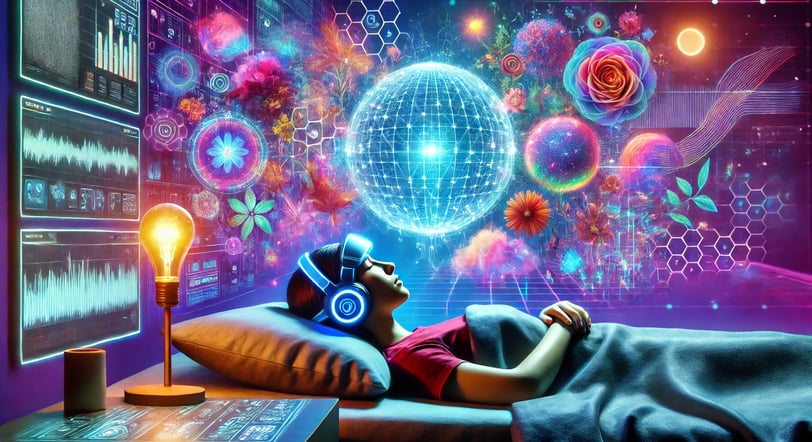AI-Driven Dream Recorders: Unlocking the Secrets of Your Subconscious
Discover the incredible potential of AI-driven dream recorders and how they’re transforming therapy, creativity, and self-discovery. Learn about futuristic gadgets like the NeuroDream Visualizer and DreamMirror VR, and see how big players like Google DeepMind and Neuralink are shaping the future of dream technology. The answers to your subconscious are closer than ever!


Introduction
Imagine being able to replay your dreams like a movie or analyze recurring patterns to uncover hidden meanings about your subconscious. This isn’t just a fantasy anymore—AI-driven dream recorders are bringing this concept closer to reality. By combining advanced neural interfaces, AI algorithms, and innovative wearable technology, these gadgets are set to revolutionize how we interpret dreams, enhance creativity, and optimize mental health.
In this blog, we’ll explore the technology behind AI dream recorders, their real-world applications, upcoming gadgets, and the big players driving this futuristic innovation.
1. How Do AI Dream Recorders Work?
AI dream recorders use advanced technology to monitor and decode brain activity during sleep, particularly during the REM (Rapid Eye Movement) phase, when most dreaming occurs.
Key Components:
Neural Signal Capture:
Devices like EEG headsets or fMRI machines record neural activity while you sleep.
AI Analysis:
Machine learning algorithms process this data to identify patterns linked to visual or emotional elements of dreams.
Visualization:
Advanced image-generation models like DALL·E transform this data into visuals, allowing users to see representations of their dreams.
Example in Action:
A lightweight AI headband detects vivid neural activity during REM sleep and, by morning, generates a short video clip of the dream, complete with colors, shapes, and recurring symbols.
2. Applications of Dream Recorders
1. Mental Health and Therapy
PTSD and Anxiety Relief:
Dream analysis can help therapists understand and address trauma triggers.
Example: A dream recorder visualizes recurring nightmares for a therapist to analyze.
Stress Management:
Devices track emotional trends in dreams and suggest coping mechanisms.
2. Creativity and Problem-Solving
Artistic Inspiration:
Artists and writers can use dream visuals as creative prompts.
Example: A filmmaker transforms a surreal dreamscape into a cinematic masterpiece.
Subconscious Problem-Solving:
Dreams often tackle unresolved problems. AI recorders could help identify solutions.
3. Sleep Optimization
Improved Sleep Quality:
Dream recorders analyze sleep cycles, suggesting adjustments for better rest.
Example: A device notices restless REM patterns and recommends a calming pre-sleep routine.
Lucid Dreaming:
Gadgets could help users achieve control over their dreams, enhancing their experience.
4. Self-Discovery
Emotional Insights:
Dreams often reflect hidden fears, desires, or stressors. AI analysis offers deeper self-awareness.
Tracking Dream Patterns:
Long-term dream analysis highlights emotional or behavioral trends.
3. Gadgets Leading the Dream Revolution
1. NeuroDream Visualizer
Features:
Uses EEG sensors to track REM sleep and AI to generate dream visuals.
Target Audience:
Artists, therapists, and sleep enthusiasts.
Why It’s Exciting:
Offers an accessible way to interpret dreams visually.
2. REMInsight AI Headband
Features:
Lightweight wearable that monitors brain activity and recommends sleep adjustments based on dream data.
Use Case:
Ideal for mental health professionals and individuals interested in sleep optimization.
3. DreamMirror VR
Features:
Combines dream recordings with immersive VR experiences, allowing users to relive and explore dreams in a 3D environment.
Potential Impact:
Could revolutionize therapy and creative brainstorming sessions.
4. DreamWeave AI Companion
Features:
Integrates with wearable devices to record dreams and provide emotional insights.
Why It’s Revolutionary:
Personalizes mental health recommendations based on dream patterns.
4. Big Companies Driving Innovation
1. Google DeepMind
Role:
Advanced AI algorithms for decoding neural signals into visual data.
Potential Contribution:
Precision in dream analysis and visualization.
2. Neuralink (Elon Musk’s Company)
Role:
Brain-machine interfaces capable of reading neural activity with unprecedented detail.
Potential Contribution:
Pioneering devices for direct brain-to-AI interaction.
3. Verily (Alphabet Subsidiary)
Role:
Biometric monitoring for health and wellness.
Potential Contribution:
Development of consumer-friendly, health-focused dream recorders.
4. Meta (Facebook Reality Labs)
Role:
Immersive VR and AR technology.
Potential Contribution:
Integration of dream recordings into VR experiences.
5. IBM
Role:
AI-driven data analysis for medical and cognitive sciences.
Potential Contribution:
Reliable and actionable insights from dream data.
5. Challenges and Ethical Considerations
Challenges:
Accuracy:
Translating complex neural signals into coherent visuals is still a developing science.
Privacy:
Dream data is deeply personal, and its protection is crucial.
Affordability:
Advanced gadgets may initially be out of reach for many users.
Ethical Concerns:
Data Ownership:
Who owns the data generated from dreams?
Potential Misuse:
Safeguards are needed to prevent misuse in legal or personal disputes.
6. The Future of AI Dream Recorders
AI-driven dream recording technology is still in its infancy but holds tremendous potential:
Dream Personalization:
Devices might allow users to design specific dream scenarios.
Shared Dreaming:
Collaborative dreaming could enhance therapy, creativity, and even social interactions.
Advanced Neural Interfaces:
Future gadgets might decode dreams with near-perfect accuracy, offering unparalleled insights into the subconscious.
Conclusion
AI-driven dream recorders are on the verge of unlocking the secrets of our subconscious, offering groundbreaking applications in therapy, creativity, and self-discovery. From gadgets like the NeuroDream Visualizer to ambitious companies like Neuralink and DeepMind, this technology is poised to transform how we perceive and utilize our dreams.
The line between reality and dreams is becoming thinner. Are you ready to step into this futuristic world where the subconscious is no longer a mystery but a tool for growth?
